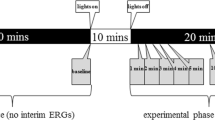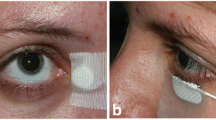Abstract
Purpose
To quantify dark-adapted (DA) skin ERG changes during 20 min of dark adaptation.
Methods
Sixteen healthy adult subjects were dark-adapted for 20 min during which ISCEV standard dim (0.01 phot cd s m−2) white flash ERGs were recorded at 1, 2, 3, 4, 5, 10, 15 and 20 min, and bright (3 phot cd s m−2) white ERGs were recorded at 2, 5, 10, 15 and 20 min without mydriasis and using skin electrodes. Amplitudes and peak times were normalised to 20 min values.
Results
Halving dark adaptation from 20 to 10 min had no measureable effect on the DA 3 ERG and caused a 10 % amplitude loss (range 0–23 %) only for the DA 0.01 ERG b-wave amplitude. No significant peak time changes resulted, nor increased parameter variability.
Conclusion
Reducing dark adaptation from 20 to 10 min or even less has an effect on only DA 0.01 ERGs. Shorter dark adaptation than 20 min may not compromise the clinical utility of the ERG providing clinics adhere to the usual standards of adequate reference data.





Similar content being viewed by others
References
Marmor MF, Arden GB, Nilsson SEG, Zrenner E (1989) Standard for clinical electroretinography: international standardization committee. Arch Ophthalmol 107:816. doi:10.1001/archopht.1989.01070010838024
Marmor MF, Zrenner E (1995) Standard for clinical electroretinography (1994 update). Doc Ophthalmol 89:199–210. doi:10.1007/bf01203373
Marmor MF, Zrenner E (1998) Standard for clinical electroretinography (1999 update). Doc Ophthalmol 97:143–156. doi:10.1023/a:1002016531591
Marmor MF, Holder GE, Seeliger MW, Yamamoto S (2004) Standard for clinical electroretinography (2004 update). Doc Ophthalmol 108:107–114. doi:10.1023/b:doop.0000036793.44912.45
Marmor MF, Fulton AB, Holder GE, Miyake Y, Brigell M, Bach M (2009) Standard for clinical electroretinography (2008 update). Doc Ophthalmol 118:69–77. doi:10.1007/s10633-008-9155-4
McCulloch DL, Marmor MF, Brigell MG, Hamilton R, Holder GE, Tzekov R, Bach M (2015) ISCEV Standard for full-field clinical electroretinography (2015 update). Doc Ophthalmol 130:1–12. doi:10.1007/s10633-014-9473-7
Schmöger E (1962) Die Rolle Der Praeadaptation Im Klinischen Erg. Acta Ophthalmol Scan 40(S70):32–50. doi:10.1111/j.1755-3768.1962.tb00305.x
Bornschein H (1962) Explanation of recommendation 9. Acta Ophthalmol Scan 40(S70):100–107. doi:10.1111/j.1755-3768.1962.tb00311.x
Cameron AM, Mahroo OAR, Lamb TD (2006) Dark adaptation of human rod bipolar cells measured from the b-wave of the scotopic electroretinogram. J Physiol 575(2):507–526. doi:10.1113/jphysiol.2006.108027
Fulton AB, Rushton WAH (1978) The human rod ERG: Correlation with psychophysical responses in light and dark adaptation. Vis Res 18:793–800. doi:10.1016/0042-6989(78)90119-0
Thomas MM, Lamb TD (1999) Light adaptation and dark adaptation of human rod photoreceptors measured from the a-wave of the electroretinogram. J Physiol 518:479–496. doi:10.1111/j.1469-7793.1999.0479p.x
Mahroo OAR, Lamb TD (2004) Recovery of the human photopic electroretinogram after bleaching exposures: estimation of pigment regeneration kinetics. J Physiol 554:417–437. doi:10.1113/jphysiol.2003.051250
Ruseckaite R, Lamb TD, Pianta MJ, Cameron AM (2011) Human scotopic dark adaptation: comparison of recoveries of psychophysical threshold and ERG b-wave sensitivity. J Vis 11:2. doi:10.1167/11.8.2
Cameron AM, Miao L, Ruseckaite R, Pianta MJ, Lamb TD (2008) Dark adaptation recovery of human rod bipolar cell response kinetics estimated from scotopic b-wave measurements. J Physiol 586:5419–5436. doi:10.1113/jphysiol.2008.160028
Abdlseaed A Al (2014) Pupil dilation, light source, gender and pigmentation effects on normal adult human ERGs, and an exploration of short latency VEPs. Ph.D. thesis, Glasgow Caledonian University
Armstrong RA (2013) Statistical guidelines for the analysis of data obtained from one or both eyes. Ophthalmic Physiol Opt 33:7–14. doi:10.1111/opo.12009
Bland JM, Altman DG (1996) Statistics notes 23: measurement error proportional to the mean. BMJ 313:106. doi:10.1136/bmj.313.7049.106
Wali N, Leguire LE (1991) Dark-adapted luminance-response functions with skin and corneal electrodes. Doc Ophthalmol 76:367–375. doi:10.1007/bf00142675
Hamilton R, Abdlseaed AA, Healey J, Neveu MM, Brown L, Keating D, McBain VA, Sculfor D, Thompson DA (2015) Multi-centre variability of ISCEV standard ERGs in two normal adults. Doc Ophthalmol 130:83–101. doi:10.1007/s10633-014-9471-9
Horowitz GL (2010) EP28-A3C defining, establishing, and verifying reference intervals in the clinical laboratory; approved guideline, 3rd edn. Clinical and Laboratory Standards Institute, Pennsylvania
Freund PR, Watson J, Gilmour G, Sauvé Y (2011) Differential changes in retina function with normal aging in humans. Doc Ophthalmol 122:177–190. doi:10.1007/s10633-011-9273-2
Birch DG, Anderson JL, Fish GE (1999) Yearly rates of rod and cone functional loss in retinitis pigmentosa and cone-rod dystrophy. Ophthalmology 106:258–268. doi:10.1016/s0161-6420(99)90064-7
Berson EL, Sandberg MA, Rosner B, Birch DG, Hanson AH (1985) Natural course of retinitis pigmentosa over a three-year interval. Am J Ophthalmol 99:240–251. doi:10.1016/0002-9394(85)90351-4
Chambers W (2005) Regulatory perspectives. Special Session on Drug Development & Clinical Trials, International Society for Clinical Electrophysiology of Vision Symposium, Glasgow, UK, August 2005. ISCEV Publications, ISBN 0-9527391-2-7
Jackson GR, Owsley C, McGwin G Jr (1999) Aging and dark adaptation. Vis Res 39(23):3975–3982. doi:10.1016/S0042-6989(99)00092-9
Neveu MM, Dangour A, Allen E, Robson AG, Bird AC, Uauy R, Holder GE (2011) Electroretinogram measures in a septuagenarian population. Doc Ophthalmol 123(2):75–81. doi:10.1007/s10633-011-9282-1
Acknowledgments
We would like to thank the subjects and members of CEVnet for responses to questions regarding the origin of the 20 min minimum dark adaptation duration.
Author information
Authors and Affiliations
Corresponding author
Ethics declarations
Conflict of interest
The authors declare that they have no conflict of interest
Rights and permissions
About this article
Cite this article
Hamilton, R., Graham, K. Effect of shorter dark adaptation on ISCEV standard DA 0.01 and DA 3 skin ERGs in healthy adults. Doc Ophthalmol 133, 11–19 (2016). https://doi.org/10.1007/s10633-016-9554-x
Received:
Accepted:
Published:
Issue Date:
DOI: https://doi.org/10.1007/s10633-016-9554-x




